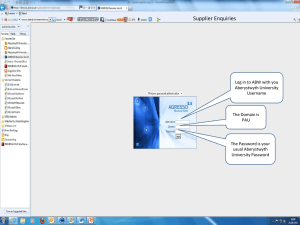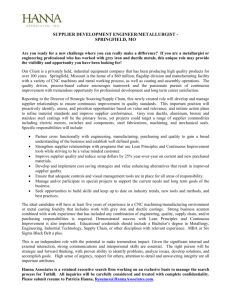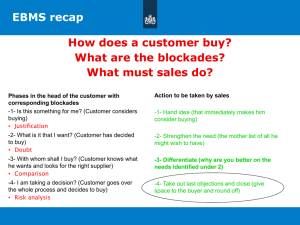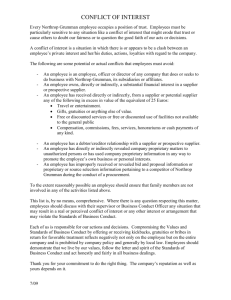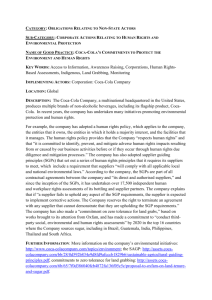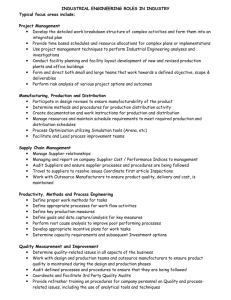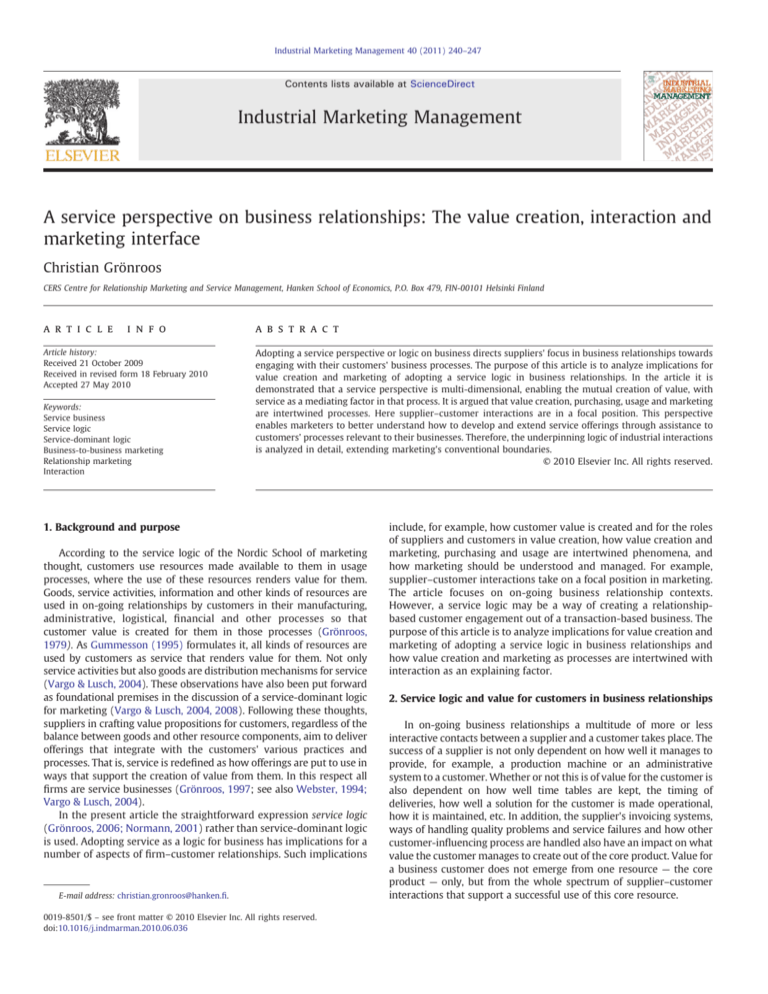
Industrial Marketing Management 40 (2011) 240–247
Contents lists available at ScienceDirect
Industrial Marketing Management
A service perspective on business relationships: The value creation, interaction and
marketing interface
Christian Grönroos
CERS Centre for Relationship Marketing and Service Management, Hanken School of Economics, P.O. Box 479, FIN-00101 Helsinki Finland
a r t i c l e
i n f o
Article history:
Received 21 October 2009
Received in revised form 18 February 2010
Accepted 27 May 2010
Keywords:
Service business
Service logic
Service-dominant logic
Business-to-business marketing
Relationship marketing
Interaction
a b s t r a c t
Adopting a service perspective or logic on business directs suppliers' focus in business relationships towards
engaging with their customers' business processes. The purpose of this article is to analyze implications for
value creation and marketing of adopting a service logic in business relationships. In the article it is
demonstrated that a service perspective is multi-dimensional, enabling the mutual creation of value, with
service as a mediating factor in that process. It is argued that value creation, purchasing, usage and marketing
are intertwined processes. Here supplier–customer interactions are in a focal position. This perspective
enables marketers to better understand how to develop and extend service offerings through assistance to
customers' processes relevant to their businesses. Therefore, the underpinning logic of industrial interactions
is analyzed in detail, extending marketing's conventional boundaries.
© 2010 Elsevier Inc. All rights reserved.
1. Background and purpose
According to the service logic of the Nordic School of marketing
thought, customers use resources made available to them in usage
processes, where the use of these resources renders value for them.
Goods, service activities, information and other kinds of resources are
used in on-going relationships by customers in their manufacturing,
administrative, logistical, financial and other processes so that
customer value is created for them in those processes (Grönroos,
1979). As Gummesson (1995) formulates it, all kinds of resources are
used by customers as service that renders value for them. Not only
service activities but also goods are distribution mechanisms for service
(Vargo & Lusch, 2004). These observations have also been put forward
as foundational premises in the discussion of a service-dominant logic
for marketing (Vargo & Lusch, 2004, 2008). Following these thoughts,
suppliers in crafting value propositions for customers, regardless of the
balance between goods and other resource components, aim to deliver
offerings that integrate with the customers' various practices and
processes. That is, service is redefined as how offerings are put to use in
ways that support the creation of value from them. In this respect all
firms are service businesses (Grönroos, 1997; see also Webster, 1994;
Vargo & Lusch, 2004).
In the present article the straightforward expression service logic
(Grönroos, 2006; Normann, 2001) rather than service-dominant logic
is used. Adopting service as a logic for business has implications for a
number of aspects of firm–customer relationships. Such implications
E-mail address: christian.gronroos@hanken.fi.
0019-8501/$ – see front matter © 2010 Elsevier Inc. All rights reserved.
doi:10.1016/j.indmarman.2010.06.036
include, for example, how customer value is created and for the roles
of suppliers and customers in value creation, how value creation and
marketing, purchasing and usage are intertwined phenomena, and
how marketing should be understood and managed. For example,
supplier–customer interactions take on a focal position in marketing.
The article focuses on on-going business relationship contexts.
However, a service logic may be a way of creating a relationshipbased customer engagement out of a transaction-based business. The
purpose of this article is to analyze implications for value creation and
marketing of adopting a service logic in business relationships and
how value creation and marketing as processes are intertwined with
interaction as an explaining factor.
2. Service logic and value for customers in business relationships
In on-going business relationships a multitude of more or less
interactive contacts between a supplier and a customer takes place. The
success of a supplier is not only dependent on how well it manages to
provide, for example, a production machine or an administrative
system to a customer. Whether or not this is of value for the customer is
also dependent on how well time tables are kept, the timing of
deliveries, how well a solution for the customer is made operational,
how it is maintained, etc. In addition, the supplier's invoicing systems,
ways of handling quality problems and service failures and how other
customer-influencing process are handled also have an impact on what
value the customer manages to create out of the core product. Value for
a business customer does not emerge from one resource — the core
product — only, but from the whole spectrum of supplier–customer
interactions that support a successful use of this core resource.
C. Grönroos / Industrial Marketing Management 40 (2011) 240–247
241
Fig. 1. The customer and supplier processes and their impact on the business processes.
As MacMillan and McGrath (1997) observe, to differentiate a
market offering a supplier must not concentrate on the core product
only, but take into account the customers' various practices and ask
itself, for example, the following questions: How do customers order
and purchase products (goods and service activities)? How are
products delivered? What happens when they have been delivered?
How are they installed? How are they paid for? How are products
stored? How are they moved around? What are customers really
using products for? What do they need help with when they use the
products? How are products repaired and serviced? What happens
when products are disposed of or no longer used?
In its contacts with a supplier a business customer moves through a
chain of everyday practices that all need support, either by the supplier
or by actions taken by the customer or by a third party. The customer's
practices have corresponding practices on the supplier side, and this set
of corresponding practices should meet in ways that help the customer's
activities flow towards a successful and profitable business outcome. In
the upper part of Fig. 1 typical corresponding customer and supplier
practices in an industrial relationship are illustrated.
According to a traditional manufacturing approach, following
what could be labeled as a goods logic, the supplier, for example
producing and selling a production machine, would concentrate on
how well the machine fits the customer's production process — on
what can be called operational efficiency. A dependable machine that
fits the customer's production process in a technically efficient way is
in the supplier's focus. A goods logic can be described as a business
logic, where resources are provided to a given usage process for the
customer's use in order to support that particular process in a valuecreating way (Grönroos, 2006). It remains the responsibility of the
customer to make sure that it can make effective use of the resource so
that value can be created out of the resource purchased.
A service business, i.e. a firm that has adopted a service logic,
would take a much further-reaching responsibility for a customer's
everyday practices and how they ultimately support the customer's
business. According to a service business logic, the supplier supports
the customer's practices with an extended offering, including goods
components and a range of service activities, which enable the
customer to create value out of the core process (e.g. a production
process). Ultimately, this extended offering provides successful
support to the customer's business process. The core customer
process (e.g. a production process) is supported by the core of the
supplier's market offering (e.g. a production machine), whereas the
customer's business is supported by the entire extended offering,
including the machine and support to other customer processes
important to the business. In this way this supplier does not only
provide resources but serves its customer's business, and therefore,
this offering can be characterized as an extended service offering.
The connection with the business process is indicated by the lower
part of Fig. 1. In order to make this connection, the supplier has to gear
all its processes relevant to the customer's business towards the
customer's corresponding processes. In the figure this process is
labeled practice matching and is indicated by the arrows between
corresponding supplier and customer processes.1 Hence, a service
logic means that a supplier does not provide resources for the
customers' use only, but instead it provides support to its customers'
business processes through value-supporting ways of assisting the
customers' practices relevant to their business (business effectiveness
instead of operational efficiency only).
In conclusion, service is to support customers' practices and business
outcomes with a set of resources and interactive processes (Grönroos,
2008:300). In other words, in a business relationship, an extended service
offering is an interactive process consisting of several sub-processes and
resources supporting corresponding customer practices in a way that helps
the customer create value in all its practices (operational efficiency), and
through this ultimately has a value-creating impact on the customer's
business process (business effectiveness). Order taking, deliveries,
installing, product specifications and features as well as product
documentation, maintenance, invoicing, complaints handling and
service recovery are examples of sub-processes and resources included
in such a market offering. Correspondingly, order making, storage,
installing, using, maintaining, paying and cost control, having problems
and mistakes corrected are examples of the customer's practices that
need support. Thus the following proposition can be formulated:
1. Implementing a service logic and providing support to the customers'
business requires that the supplier extends its market offering to
include activities and processes that support practices and processes
1
Practice matching means that the supplier and the customer develop or strive to
develop the way they practice corresponding processes with an aim to be able to
jointly support value creation in the customer's processes and for the customer's
business. Simultaneously the supplier's creation of value from this business
engagement should be supported.
242
C. Grönroos / Industrial Marketing Management 40 (2011) 240–247
that are relevant to the customers' business (i.e. that have a business
effectiveness influence).
3. What is the value for customers in a business-to-business
context?
In the literature on value creation and co-creation, value is often
discussed on a philosophical level. In the most frequently used
approach, value is a relationship between what one benefits and what
one sacrifices (see Sánchez-Fernández & Iniesta-Bonilla, 2007). On a
general level, as a working definition, value for customers can be
described in the following way: Value for customers means that they,
after having been assisted by the provision of resources or interactive
processes, are or feel better off than before (Grönroos, 2008:303;
slightly abbreviated; compare also Vargo, Maglio, & Akaka, 2008).
In business-to-business contexts, the support of a supplier will
always have some effect on the economic result of the customer's
business. The profitability of a business is dependent on how well the
firm's various practices (order making, storing, producing, maintaining, paying, having mistakes corrected, etc.) function not only in terms
of operational efficiency but also in terms of business effectiveness, i.e.
how effectively various practices support either the firm's growth- and
revenue-generating capacity or cost level, or both. How well such
practices function and have positive effects on revenues and costs is
dependent of how well they are supported by the firm's suppliers.
Hence, the roots of a firm's economic result can be traced back to how
well the firm's various practices are supported by its suppliers, in terms of
the revenue and cost effects created by this support. Therefore, value for
customers can be measured in monetary terms. In addition, value also
has a perceptional dimension, for example, trust, commitment and
attraction.
In conclusion, what value a customer can create out of the support
provided by a supplier can be divided into three dimensions:
1. Effects on the customer's growth- and revenue-generating capacity
a. Business growth opportunities (new markets, better customer
or customer segment penetration)
b. Higher margins through premium pricing
2. Effects on the customer's cost level
c. Lower operative and/or administrative costs
d. Higher margins through lower operating/administrative costs
3. Effects on perceptions
e. Increased trust in the supplier
f. Increased commitment to the supplier
g. Increased comfort in supplier interactions
h. Increased attraction of the supplier.
In principle the two first types of value-creating effects can be
measured in monetary terms. The third effect can only be measured as
perceptions and cognitive effects. From the supplier's point of view,
calculating the revenue and cost effects of an extended market
offering (service offering) is a way of motivating a price tag on service.
4. Value as value-in use — the customer as the value creator
In the contemporary marketing and management literature as well
as in the discussion about service logic, there is a common
understanding that value is created in the users' processes as valuein-use (see for example, Normann & Ramirez, 1993; Holbrook, 1994,
1996; Ravald & Grönroos, 1996; Vandermerwe, 1996; Wikström,
1996; Woodruff & Gardial, 1996; Normann, 2001; Prahalad, 2004;
Vargo & Lusch, 2004; Grönroos, 2006, 2008; Lush, Vargo, & O'Brien,
2007, to mention a few publications). Also in axiology, or the
philosophy of value, value is considered to be created by the
customers during use of goods and services (e.g., Holbrook, 1999;
Lamont, 1995; Mattsson, 1991).
However, especially in publications on service as a logic for
business and marketing, the expression “value creation” is used to
mean more than one phenomenon. On one hand, value creation
means the customer's creation of value-in-use. On the other hand, as
in the expressions ‘the customer is always a co-creator of value’ (e.g.
Vargo & Lusch, 2004, 2008) and ‘the firm is not a value creator but a
co-creator of value’ (e.g. Lusch, Vargo, & Wessels, 2008), it is also used
to mean the entire process of development, design, manufacturing
and delivery as well as back-office and front-office activities and also
including the customer's creation of value-in-use.
To avoid the confusion caused by this unspecific use of “value
creation”, in the present article the two above mentioned processes
are conceptually kept apart. The following definitions are introduced:
The term “value creation” and the expression “value-creating process”
are used only for the customer's creation of value-in-use. The reason
for this is that in the contemporary literature on marketing and
management, as in the literature on axiology, customers are seen as
the ones who create value out of resources they have obtained.
Therefore, the term “value creation” is logically used for this very
process of customer's creation of value and for nothing else. For the
much more extensive process of developing, designing, manufacturing and delivering as well as firm's back-office and front-office
activities and also including customer creation of value-in-use, the
terms “value generation” and “value-generating process” are used.
Using this distinction between value creation and value generation, it is possible to create an understanding of how value for
customers really emerges and to develop a terminology that can be
used to explain and analyze this process. This would be one answer to
the question Vargo et al. (2008) raise in a recent article: “This
exploration of value co-creation raises as many questions as it
answers. For example: What exactly are the processes involved in
value co-creation?” (p. 451).
In the 1960s the economist and Nobel Prize winner Gary Becker
(1965) described this view of value creation in a consumer context in
his discussion of the household as a utility or value producing unit.
Firms supply the household with the resources, such as goods, service
activities and information, which the household needs in order to
create value (or utility) for itself. Also in service marketing research
this was observed very early: “A good represents potential value (or
utility) for the consumer. He purchases the good and subsequently he
has to initiate and implement the activities required to transform this
potential value into real value for him” (Grönroos, 1979:86).
Following the value-in-use notion, it can be concluded that it is the
customer who is the value creator in a business relationship. As an
adjunct to the value-in-use notion, to say that the customer always is
a co-creator of value gives the wrong impression of the pivotal role
held by the customer in the creation of value-in-use. In some
situations, the customer may co-create value-in-use, but the important aspect to emphasize is that the customer as the user of resources
is the value creator. The sub-processes of the entire value-generating
process including the roles of suppliers and users need to be further
explored. Therefore, in a later section the roles of the supplier, and the
customer, in value generation for customers will be discussed.
Since the early days of modern service marketing research,
customer participation in service production processes and the
customers' role as co-producers of service activities and marketing
implications that follow have been recognized (Eiglier & Langeard,
1975; Grönroos, 1982). The fact that customers participate as coproducers in firms' production processes means that customers
engage themselves with the firms' work or processes (see, for
example, Lengnick-Hall, Claycomb, & Inks, 2000; Auh, Bell, McLeod,
& Shih, 2007). Perhaps it is from this observation of customers as coproducers that the thought has emerged in the recent literature that
also in the context of value creation customers are given opportunities
to engage themselves with the firm's processes, but in this case as
value co-creators in the firm's creation (or co-creation) of value for
C. Grönroos / Industrial Marketing Management 40 (2011) 240–247
them. However, as it is the customers who create value, in the context
of value creation this statement is misleading. Mixing co-production
with value creation may have contributed to what appears to be
confusing in the literature as to the roles of firms and customers in the
creation of value-in-use.2 Distinguishing between value generation as
the entire process leading to value-in-use for a customer as the end
state of that process, and value creation as the customer's creation of
value-in-use helps overcoming this confusion. Thus the following
proposition can be formulated:
2. When adopting a value-in-use notion, the customer is the value
creator.
5. The roles of value and service in business
Value and value creation has been found to be a foundational
aspect in marketing and business (e.g., Alderson, 1957; AMA
marketing redefinition attempts, 2004 and 2007; CIM the Chartered
Institute of Marketing re-evaluation of the marketing definition, 2007;
Drucker, 1954; Grönroos, 1997; Holbrook, 1994; Rust & Oliver, 1994;
Sheth & Uslay, 2007). The objective of adopting a service logic in
business is to enable value creation for both the customer and the
supplier. As Gummesson (1995) observed, all kinds of resources are
used by customers to render service that create value for them. This
raises the question, what is the role of service and value, respectively
in business? As Vargo & Lusch (2008; see also Lusch et al., 2008) state,
service is a logic for understanding value creation (and marketing). This
is also implied by Gummesson's (1995) observation.
Hence, what should be achieved by providing service is not service
for the other party in the business engagement per se, but value for
both parties involved in the business engagement. The ultimate goal is
to support value creation for the customer and enable value creation by
the supplier. Therefore, based on today's emphasis on value-in-use,
the goal of business is reciprocal value creation, with service as a
mediating factor in this process. (Grönroos & Ravald, 2009)
6. The supplier's role in value generation: value facilitation and
co-creation
Developing, designing, manufacturing and delivering, for which
the collective term “production” is used in this article, and value
creation are not the same thing. They are part of the entire process of
value generation. In production processes the resources (goods,
service activities and other resources) that render value for customers
are produced. Production takes place in the supplier's sphere. Value
creation, on the other hand, takes place in the customers' valuecreating processes, where a range of resources are used. Their value is
created out of the resources available. Value creation takes place in the
customers' sphere (Vandermerwe, 1996). Hence, production and
value creation are separate processes that get intertwined only under
certain circumstances. They are also different constructs. Therefore,
neither of them can be considered a superordinate concept.3
What suppliers can do in the value-generating process to support
value creation is to provide their customers with resources that can be
used by them, together with other available resources. In this way
suppliers facilitate value creation (of value-in-use). Consequently, this
task undertaken by suppliers can be labeled value facilitation
(Grönroos, 2008:306-307; Grönroos & Ravald, 2009). However, as
supplier and customer processes are in part simultaneously occurring
processes, interactions between suppliers and their customers take
place. During these interactions co-producing opportunities exist for
2
Notably, Ballantyne and Varey (2006) have suggested alterative conceptual
understandings for value creation and for value production.
3
Value creation (or co-creation) has been suggested as a superordinate concept in
relation to production (or co-production) (Vargo & Akaka, 2009).
243
customers. From a production point of view (production in this sense
including both manufacturing processes and the execution of, for
example, order taking, logistical, maintenance invoicing and complaints handling and problem recovery and other processes),
customers may engage with the supplier's production process.
Looking at the interactions from a value creation perspective, the
situation may be quite different. Value creation (of value-in-use)
takes place in the user's sphere, and therefore, it is the supplier that is
invited to engage with the customer's usage processes, in order to
support the customer's value creation. This is a truly outside-in
approach in accordance with the marketing concept. The supplier's
involvement in its customers' usage processes during interactions
with the customers opens up additional opportunities for suppliers to
influence customers' value creation. During the interactions the
supplier can directly work with the customers and actively influence
the flow and outcome of their value-creating processes. However,
according to the value-in-use notion, customers create value. As
stated earlier, supplier production aims to facilitate customer value,
but customers will always determine what is of value. Not
differentiating adequately the terms production of resources and
facilitation of customers' value creation by providing such resources
arguably creates much confusion as to the roles of the parties in the
business engagement, and the ways they can work towards the
creation of value for customers.
As Storbacka and Lehtinen (2001) state, customers produce value
for themselves independently, but suppliers may offer assistance.
However, during part of the value-creating process, specifically during
interactions with users, in addition to its role as value facilitator, the
supplier may become a co-creator of value as well (Grönroos,
2008:307). Co-creation opportunities that suppliers have are strategic
options for creating value (Payne, Storbacka, & Frow, 2008). These
interactions involving co-creation of value are dialogical, where both
parties influence each other's perceptions and actions (Ballantyne,
2004; Ballantyne & Varey, 2006). Suppliers' co-creation of value-inuse for their customers takes place together with the customers.
Because the customer creates value-in-use, without the existence of
interactions the supplier has no value co-creation opportunities.
Therefore, value co-creation is a joint value creation process, which
requires the simultaneous presence of both customer and supplier. In
isolation from each other, the supplier facilitates the creation of valuein-use, and the customer as sole value creator creates value-in-use. In
the next sections on interaction and its implications for value creation
and marketing the underpinning logic of suppliers' value co-creation
opportunities are analyzed further.
In Fig. 2 the relationships between production and value creation
as well as the position of interactions in relation to the supplier's
production processes and the customer's value-creating (and usage)
processes are schematically illustrated. The figure shows that
interactions can be viewed both from a production perspective and
from a value creation perspective, respectively. From the former
perspective, as illustrated in the upper left corner of the figure,
interactions are joint production processes, in which the customer as
co-producer participates with the supplier. From the latter perspective, as illustrated in the lower right corner of the figure, interactions
are joint value creation processes, in which the supplier as co-creator of
value participates with the customer. In this context co-creation
means that two (or more) parties together influence the emergence of
value-in-use.
The value-generating process is not as linear as the figure implies.
The customer may also, for example, initiate the development of new
resources or solutions. In that case the process of value creation may
start with an interaction, where co-creation of value by the parties
involved takes place. This phase may lead to another production
phase, where no interactions occur. This phase may, for example,
include manufacturing of a resource. After that, interactions may
occur again during, for example, deliveries and installing, which
244
C. Grönroos / Industrial Marketing Management 40 (2011) 240–247
Fig. 2. Value creation and the phases of the value-generating process.
enable co-creation of value for the supplier. Then the resources are
used by the customer in a continuous value-creating process up until,
for example, a maintenance activity again enables the supplier to get
involved in the customer's value creation as co-creator of value.
Interaction and joint value creation can take place throughout the
value-generating process, during development, design, manufacturing, deliveries and front-office processes. If this is the case, the
customer participates as co-developer, co-designer, co-producer, etc.
in the firm's processes. At the same time this enables the firm to
engage itself in value co-creation within the customer's valuecreating process. During non-interactive production phases the
supplier is a value facilitator aiming at producing an output that
supports or facilitates the customer's value-creating process.
Thus the following propositions can be formulated:
3. The supplier's basic role in the value-generating process is to facilitate
the customers' value creation.
4. During interactions with customers the supplier can engage itself with
the customers' value creation and become co-creators of value with
them.
7. The nature of interactions and their implications for joint value
creation
No joint value creation exists and no co-creation of value can take
place, unless interactions between the supplier and the customer
occur. Especially within the Nordic school research tradition, the
interaction concept is a key construct in relationship marketing (e.g.,
Grönroos, 1982; Gummesson, 2002) and in service marketing, for
example in the form of buyer–seller interactions and interactive
marketing (e.g., Grönroos, 1982), part-time marketers (e.g., Gummesson, 1991) and interaction quality (e.g., Lehtinen & Lehtinen,
1991). However, interaction has also been discussed to some extent
within other service research traditions (e.g., Solomon, Surprenanat, &
Czepiel, 1985).4
4
For discussions of the interaction concept in other contexts, see for example
Håkansson (1982), Håkansson and Snehota (1995), Dwyer, Shurr, and Oh (1987), Jap,
Manolis, and Weitz (1999), Day and Montgomery (1999), Rayport and Jaworski
(2005), Yadav and Varadarajan (2005), and Ramani and Kumar (2008).
In general terms interaction is mutual or reciprocal action where two
or more parties have an effect upon one another. An inherent aspect of
interaction is connectivity, i.e. the parties involved are in some contact
with each other. In a business context supplier–customer interactions
mean that two or more parties are in contact with each other for a
business reason, and in these contacts they have opportunities to
influence one another's processes.
Traditionally, in typical goods-marketing situations the supplier
provides its customers with goods as input resources into their
practices. The goods are more or less standardized and after delivery,
unless prompted by the customer, the supplier cannot take actions to
influence them. Joint R&D activities and product and service
development as well as joint processes of matching corresponding
supplier and customer practices (see Fig. 1) provide an interactive
platform, where the customer can influence the supplier's processes
and the supplier can influence the customer's value creation. By
adding, for example, call center services, interactive systems for order
taking, logistics or diagnosing problems a goods marketer creates
interactions with its customers. In all these cases, the supplier,
through the development of interactions, creates opportunities to
engage itself with its customers' practices and to influence them and
their outcomes.
The customer's and the supplier's practices flow partly as parallel
processes. For example, order making and order taking may include
interactions between people, between people and automatic systems
or even between systems, or maintenance activities include interactions between people and even between automatic systems representing the supplier and the customer, respectively. The same goes for
a range of supplier practices that are needed for influencing other
corresponding customer practices. Such corresponding processes
occur partly simultaneously and in parallel with each other. From a
value creation perspective they are communicative interactive
processes (Ballantyne, 2004; Ballantyne & Varey, 2006) that can
merge into one integrated process, where both parties are active and
may directly influence each other. The supplier operates as an
integrated part of the customer's process, and the customer operates
as an integrated part of the supplier's process.
The mere existence of an interaction does not automatically imply
that direct actions that influence the other party are or even can be
taken by the supplier or customer. It is important to realize that, from
C. Grönroos / Industrial Marketing Management 40 (2011) 240–247
the supplier's point of view, the existence of interactions is only a
platform for influencing the customers' usage processes. However, the
quality of the interactions between the parties is fundamental for
value co-creation (compare Fyrberg & Jüriado, 2009:422). The more
actively the supplier manages to make use of the interaction platform,
the more the employees and systems representing the supplier are
engaged with the customers' value creation, and the more opportunities for co-creating value it has. Thus the following propositions can
be formulated:
5. Value co-creation requires that customer–supplier interactions occur.
6. The quality of interactions (i.e. how well the supplier can make use of
them to influence the customer's value creation) has an impact on
how well the supplier can make use of value co-creation
opportunities.
8. Marketing implications of interactions and the supplier's value
co-creation opportunities
Both in marketing practice and in academic discussions value for
customers has become a key concept. In addition, as was pointed out
previously, mutual value creation can be viewed as a goal of business,
where service is a mediating factor. In its efforts to update its
marketing definition during the 2000s, the American Marketing
Association has taken a new stance and distinctly based its new view
of marketing on value creation. In both the American Marketing
Association's and The Chartered Institute of Marketing's redefinition
attempts in the UK during the 2000s value has been pointed out as a
pivotal issue (AMA marketing redefinition attempts, 2004 and 2007;
CIM the Chartered Institute of Marketing re-evaluation of the
marketing definition, 2007). Building on the AMA efforts to redefine
marketing, Sheth and Uslay (2007); (see also, for example, Holbrook,
1994; Rust & Oliver, 1994; and Grönroos, 1997) have argued that
focusing marketing on value creation indeed may be a contemporary
marketing focus. Focusing on value creation as the ultimate goal for
marketing may be an answer to the challenge posed by Alderson
(1957) over half a century ago, namely that rather than finding out
what utility, or value, is created by marketing, what is needed is “a
marketing interpretation of the whole process of creating utility” (p.
69). It also corresponds with Drucker's (1954) conclusion that it is
what customers do with firms' output and what they think is value for
them that is decisive for any business.
From the underpinning logic of service, based on the notion that in
order to support customers' value creation the supplier should strive
to get involved in the customer's processes, such as purchasing, order
making, storing goods, paying, using, maintaining, updating, having
mistakes and failures corrected, getting advice, and scrap disposal, the
following formulation of the goal for marketing can be derived
(Grönroos, 2009:353):
The goal for marketing is to engage the firm with the customers'
processes with an aim to support value creation in those processes, in
a mutually beneficial way.
This way of expressing marketing's goal is in line with the
relationship marketing definition, which, according to Harker (Harker,
1999; Harker & Egan, 2006), best reflects the aspects of relationship
marketing mentioned in the literature. According to this definition (e.g.,
Grönroos, 2007:275), relationship marketing is defined as the process of
establishing, maintaining and enhancing, and when necessary terminating relationships with customers, for the benefit of all involved
parties, through a process of making and keeping promises. Making
promises requires that the supplier engages itself with its customers'
processes in the first place (sales, marketing communication, offers, etc.).
Keeping promises relates to how the supplier continuously supports the
245
various processes relevant to its customers (order making, storing goods,
paying, using, maintaining, etc.).
Keeping promises well means that the customers' processes are
supported in a successful and value-creating way. Hence, the
supplier's capability to support value creation through value facilitation (providing appropriate goods and service activities and other
resources) and value co-creation during interactions with customers
in a variety of customer practices determines its marketing success.
From a marketing point of view the value co-creation opportunities mean that, during the interactive joint value creation process with
the customer, the supplier as part of the customers' processes is part of
their value creation. This means that the supplier is not restricted to
making promises of potential value for the customers only.5 If that were
the case, no co-production activities and especially no direct and
active efforts by the supplier influencing the customer's usage and
value-creating process would take place.
In summary, it can be concluded that the value co-creation
opportunities for suppliers created by the adoption of a service logic
on business, and the utilization of firm–customer interactions, open
up new opportunities for suppliers to develop their marketing
strategies in ways that previously were unique to service firms only.
The analysis demonstrated how the interaction phenomenon enables
a supplier adopting a service logic to break free from the goods logic
restriction of being able to make promises, or offer value propositions,
only. Thus the following proposition can be formulated:
7. Suppliers adopting a service logic are not restricted to making value
propositions only, but are enabled to directly engage themselves with
keeping promises inherent in value propositions made.
9. Conclusions and implications for management and research
The analysis of value creation and marketing implications for
business relationships, due to the adoption of a service perspective on
business, reveals some new avenues for understanding business-tobusiness marketing. Value creation and marketing turn out to be
intertwined. The opportunities for suppliers to engage themselves
with their customers' value creation offer unique opportunities for
suppliers to extend their marketing (and sales) activities into the
customers' sphere by incorporating activities during firm-customer
interactions in the marketing process. This makes new marketing
strategies possible. The suppliers' active and direct involvement in the
customers' value creation through value co-creation activities with
them provides interactive marketing6 opportunities that firms adopting a conventional goods logic do not have. Hence, as has been
summarized in the propositions derived from the analysis in the
present article, the adoption of a service logic in business is based on
the following premises:
1. Service as a phenomenon means support by one party for another
party's practices and processes. In on-going business-to-business
relationships the implementation of a service perspective or logic
may require practice matching aiming at aligning corresponding
supplier and customer processes and competencies.
2. In order to understand the supplier's and the customer's roles and
activities, the customer's creation of value-in-use, in this article
called value creation, and the entire process of value generation,
starting with the development of resources and ending with the
5
In the discussion of a service-dominant logic it is invariably claimed that service as
a business perspective means that the firm can offer value propositions only (e.g.
Vargo & Lusch, 2004, 2008). As a value proposition is a suggestion or promise about
something that has not materialized for the customer yet, this statement must be due
to a negligence or misunderstanding of the interaction concept.
6
Interactive marketing was introduced in service marketing research as a term
describing the marketing aspect of the performance of employees involved in
simultaneously occurring service production and consumption processes (Grönroos,
1982).
246
3.
4.
5.
6.
C. Grönroos / Industrial Marketing Management 40 (2011) 240–247
customer's creation of value-in-use out of such resources, must be
kept apart conceptually.
Interaction is a defining characteristic of the adoption of a service
logic that integrates marketing with value creation, and this has
fundamental implications for both value generation and the future
scope and relevance of marketing.
Reciprocal value creation for all parties in a business engagement is an
ultimate basis of business. Service is a mediator variable in this process.
Suppliers cannot create value. Their role is fundamentally that of a
value facilitator providing customers with value-supporting
resources and interactive processes that facilitate the customers'
value creation. In addition to being value facilitators, during
interactions with their customers, suppliers can get opportunities
to get involved in joint value creation processes and become value
co-creators with them as well.
Value co-creation with customers offers the suppliers opportunities to
extend their market offering to include activities during the customers'
value-creating process. Thus, in their marketing strategies and
processes firms are not restricted to making promises of potential
value (or value proposition) only, but can include activities performed
by people involved in interactions with customers as part-time
marketers (interactive marketing) that directly and actively influence
the customers' value fulfillment as well.
The implications for industrial marketing management are
extensive. Marketing has mainly been a promise making process,
where the responsibility for keeping promises and creating loyalty
have been in the hands of other functions in a firm (see Brown,
2005:3). Now the execution of activities, such as deliveries, repair and
maintenance, customer training, problem recovery, invoicing, can be
incorporated in the marketing process, and when doing so, marketing
becomes influential in promise keeping and loyalty creating. Longexisting concepts from service marketing research, such as interactive
marketing (Grönroos, 1982), part-time marketers (Gummesson,
1991) and internal marketing (Eiglier & Langeard, 1975; Grönroos,
1982), are emphasized in business relationships.
New marketing strategies and business models can be developed,
including new earnings logics based on extended market offerings
integrating goods and service activities from a service business
perspective. As marketing is intertwined with value and value
creation, it may also be possible to develop new value-based pricing
models, and find an effective way of putting a price on the service
activities offered to customers.
Research opportunities follow the same paths as the above mentioned
managerial implications. The adoption of service marketing concepts and
models in business relationships need further research, and further
refinement of such concepts to fit these contexts is required. Also research
into new service logic-based business models is needed. Moreover,
because a firm can create value for itself from a business relationship only
if it supports its customer's value creation, the process of reciprocal value
creation should be studied, and corresponding metrics for measuring such
value creation developed.
References
Alderson, W. (1957). Marketing behavior and executive action. Homewood, IL: Richard D.Irwin.
American Marketing Association (2007, last update October). Definition of marketing.
Available: http://www.marketingpower.com/AboutAMA/Pages/DefinitionofMarketing.aspx (August 25, 2009).
Auh, S., Bell, S. J., McLeod, C. S., & Shih, E. (2007). Co-production and customer loyalty in
financial services. Journal of Retailing, 83(3), 359−370.
Ballantyne, D. (2004). Dialogue and its role in the development of relationship specific
knowledge. Journal of Business and Industrial Marketing, 19(2), 114−123.
Ballantyne, D., & Varey, R. J. (2006). Creating value-in-use through marketing
interaction: The exchange logic of relating, communicating and knowing.
Marketing Theory, 6(3), 335−348.
Becker, G. S. (1965, September). A theory of allocation of time. The Economic Journal, 75
(299), 493−517.
Brown, S. W. (2005, October). When executives speak, we should listen and act
differently. Journal of Marketing, 69, 2−4.
Day, G., & Montgomery, D. (1999). Charting new directions for marketing. Journal of
Marketing (Special Issue), 63, 3−13.
Drucker, P. F. (1954). The practice of management. New York: Harper Collier Publishers.
Dwyer, F. R., Shurr, P. H., & Oh, S. (1987). Developing buyer–seller relationships. Journal
of Marketing, 51(2), 11−27.
Eiglier, P., & Langeard, E. (1975). Principe politique de marketing pour les enterprises de
service. Working Paper. : Institute d'Administratin des Enterprises. Université d'AixMarseille.
Fyrberg, A., & Jüriado, R. (2009). What about interaction? Networks and brands as integrators
within a service-dominant logic. Journal of Service Management, 20(4), 420−432.
Grönroos, C. (1979). Service Marketing. A study of the marketing function in service
firms (in Swedish with an English summary). Diss., Hanken School of Economics
Finland, Marketing Technique Centre and Akademilitteratur.
Grönroos, C. (1982). An applied service marketing theory. European Journal of
Marketing, 16(7), 30−41.
Grönroos, C. (1997). Value-driven relational marketing: From products to resources
and competences. Journal of Marketing Management, 13(5), 407−420.
Grönroos, C. (2006). Adopting a service logic for marketing. Marketing Theory, 6(3), 317−333.
Grönroos, C. (2007). Service management and marketing. Customer management in
service competition. Chichester: Wiley.
Grönroos, C. (2008). Service logic revisited: Who creates value? And who co-creates?
European Business Review, 20(4), 298−314.
Grönroos, C. (2009). Promise management: Regaining customer management for
marketing. The Journal of Business & Industrial Marketing, 24(5/6), 351−359.
Grönroos, C., & Ravald, A. (2009). Marketing and the logic of service: Value facilitation,
value creation and co-creation, and their marketing implications. Working paper,
No. 542, Finland: Hanken Press/Hanken School of Economics http://urn.fi/URN:
ISBN:978-952-232-061-2.
Gummesson, E. (1991). Marketing revisited: The crucial role of the part-time marketer.
European Journal of Marketing, 25(2), 60−67.
Gummesson, E. (1995). Relationship marketing: Its role in the service economy. In
William J. Glynn, & James G. Barnes (Eds.), Understanding Services Management
(pp. 244−268). New York: Wiley.
Gummesson, E. (2002). Total relationship marketing. Oxford: Butterworth Heinemann.
Harker, M. J. (1999). Relationship marketing defined? An examination of current
relationship marketing definitions. Marketing Intelligence & Planning, 17(1), 13−20.
Harker, M. J., & Egan, John (2006). The past, present and future of relationship
marketing. Journal of Marketing Management, 22(1–2), 215−242.
Holbrook, M. B. (1994). The nature of customer value — An axiology of services in the
consumption experience. In Roland T. Rust, & Richard Oliver (Eds.), Service Quality:
New Directions in Theory and Practice. Thousand Oaks, CA: Sage.
Holbrook, M. B. (1996). Customer value – a framework for analysis and research. In K. P.
Corfman, & J. G. LynchJr. (Eds.), Advances in consumer research, 23. (pp. 138−142)
Provo, Utah: Association of Consumer Research.
Holbrook, M. B. (1999). Introduction to consumer value. In Morris B. Holbrook (Ed.),
Customer value. A framework for analysis and research. London: Routledge.
Håkansson, H. (Ed.). (1982). International marketing and purchasing of industrial goods.
New York: Wiley.
Håkansson, H., & Snehota, I. (1995). Developing relationships in business networks.
London: Routledge.
Jap, S. D., Manolis, C., & Weitz, B. A. (1999). Relationship quality and buyer–seller
interactions in channels of distributions. Journal of Business Research, 46(3), 303−313.
Lamont, W. D. (1995). The value judgment. : Edinburgh University Press.
Lehtinen, U., & Lehtinen, J. R. (1991). Two approaches to service quality dimension. The
Service Industries Journal, 11(3), 287−303.
Lengnick-Hall, C. A., Claycomb, C., & Inks, L. W. (2000, March). From recipient to
contributor: Examining customer roles and experienced outcomes. European
Journal of Marketing, 34, 359−383.
Lush, R. F., Vargo, S. L., & O'Brien, M. (2007). Competing through service: Insights from
service-dominant logic. Journal of Retailing, 83(1), 5−18.
Lusch, R. F., Vargo, S. L., & Wessels, G. (2008). Toward a conceptual foundation for service
science: Contributions from service-dominant logic. IBM Systems Journal, 47(1), 5−14.
MacMillan, I. C., & McGrath, R. G. (1997, July/August). Discovering new points of
differentiation. Harvard Business Review, 133−145.
Mattsson, J. (1991). Better business by the ABC of values. Lund: Studentlitteratur.
Normann, R. (2001). Reframing business: When the map changes the landscape.
Chichester: Wiley.
Normann, R., & Ramirez, R. (1993, July-August). From value chain to value
constellation: Designing interactive strategy. Harvard Business Review, 71, 65−77.
Prahalad, C. K. (2004). The co-creation of value — Invited commentary. Journal of
Marketing, 68(1), 23.
Payne, A. F., Storbacka, K., & Frow, P. (2008). Managing the co-creation of value. Journal
of the Academy of Marketing Science, 1(36), 83−96.
Ramani, G., & Kumar, V. (2008). Interaction orientation and firm performance. Journal of
Marketing, 72(1), 27−45.
Ravald, A., & Grönroos, C. (1996). The value concept and relationship marketing.
European Journal of Marketing, 30(2), 19−30.
Rayport, J. F., & Jaworski, B. J. (2005). Best face forward. Boston, MA: Harvard Business
School Press.
Rust, R. T., & Oliver, R. L. (1994). Service quality: Insights and managerial implications
from the frontier. In Roland T. Rust, & Richard L. Oliver (Eds.), Service Quality: New
Directions for Theory and Practice (pp. 1−20). Thousand Oaks, CA: Sage.
Sánchez-Fernández, R., & Iniesta-Bonilla, M.Á. (2007). The concept of perceived value:
A systematic review of the research. Marketing Theory, 7(4), 427−451.
C. Grönroos / Industrial Marketing Management 40 (2011) 240–247
Sheth, J. N., & Uslay, C. (2007). Implications of the revised definition of marketing: From
exchange to value creation. Journal of Public Policy & Marketing, 26(2), 302−307.
Solomon, M. R., Surprenant, C., & Czepiel, J. A. (1985). A role theory perspective on
dyadic interactions: The service encounter. Journal of Marketing, 49(1), 99−111.
Storbacka, K., & Lehtinen, J. R. (2001). Customer relationship management. Singapore:
McGraw-Hill.
The Chartered Institute of Marketing (2007). Shape the agenda. Tomorrow's world. Reevaluating the role of marketing. : The Chartered Institute of Marketing publications.
Vandermerwe, S. (1996). Becoming a customer “owning” company. Long Range
Planning, 29(6), 770−782.
Vargo, S. L., & Akaka, M. A. (2009). Service-dominant logic as a foundation for service
science: Clarifications. Service Science, 1(1), 32−41.
Vargo, S. L., & Lusch, R. F. (2004, January). Evolving to a new dominant logic for
marketing. Journal of Marketing, 1−17.
Vargo, S. L., & Lusch, R. F. (2008). Service dominant logic: Continuing the evolution.
Journal of the Academy of Marketing Science, 36(1), 1−10.
Vargo, S. L., Maglio, P. P., & Akaka, M. A. (2008). On value and value co-creation: A
service systems and service logic perspective. European Management Journal, 26(3),
145−152.
Webster, F. E., Jr. (1994). Executing the new marketing concept. Marketing
Management, 3(1), 9−18.
247
Wikström, S. (1996). Value creation by company–consumer interaction. Journal of
Marketing Management, 12, 359−374.
Woodruff, R. B., & Gardial, S. (1996). Know your customers — New approaches to
understanding customer value and satisfaction. Oxford: Blackwell.
Yadav, M. S., & Varadarajan, P. R. (2005). Understanding product migration to the
electronic marketplace: A conceptual framework. Journal of Retailing, 81(2), 125−140.
Christian Grönroos is Professor of service and relationship marketing at Hanken
School of Economics, Finland. He is also the founder and the chairman of the Board of
the School's research and knowledge centre CERS (Centre for Relationship Marketing
and Service Management). He is one of the international pioneers of the research into
service marketing and its extensions into service management and relationship
marketing. He has published extensively in scientific journals. His two most recent
books are Service management and marketing: Customer management in service
competition and In search of a new logic for marketing: Foundations of contemporary
theory, both published in 2007 by John Wiley & Co (UK). In 1999 he was the first
receiver of the American Marketing Association's (Servsig) Award for Contribution to
the Services Field from outside North America. In addition to his academic career he
also has thorough experience as a consultant and executive educator. See also: http://
www.hanken.fi/staff/gronroos/.

